Read Time: 9 minutes
One of the challenges with being an equity investor is discerning between blips and paradigm shifts. Over the last thirty years, we've seen many fads with plenty of fanfare sucking in capital that was ultimately destroyed. FOMO has burnt many fingers. On the flipside, transformations such as India's IT outsourcing boom in the early 2000s, have been events facilitating genuine supernormal value creation. Our job as risk-takers is to use our research process to avoid hype whilst being alert for new-normals, that could both dramatically hurt the business models of companies within our existing portfolios and create new opportunities for reward.
What’s changed?
When a country of the size of India sees its broadband internet users nearly triple in four years to 800 million it makes sense for us as investors to reappraise the opportunity set. This note is the first of two on the impact of digitalisation of India on its public equity markets. It will focus on the landscape, what it might mean for stock-pickers and how we approach new-age businesses (Spoiler alert – it's similar to our approach to all other businesses). The second note will address how our Portfolio strategy is focusing on businesses benefiting from the mainstreaming of digitialisation.
As mentioned above, there are 800 million internet users today. This is because the cost of data (20 cents per gigabyte per month) is next to nothing, and smartphones are affordable (the cheapest costs USD 50 in India). Digital infrastructure investment from companies such as Jio, Amazon, Uber, Walmart-owned Flipkart, Google, and a plethora of domestic names with extensive private capital funding has been ongoing for many years now to the extent that a thriving e-commerce ecosystem is now a reality. The pandemic has also supercharged digital adoption.
We believe that India's Northern neighbour China provides a useful yardstick on what may transpire. China crossed the ~USD 2,500 per capita income threshold required for consumption spending to J-curve in 2006-7. This was the Digital break-out moment for China, and this is where India is now. What's encouraging is that the number of internet users in India is fast catching up. This can have a knock-on acceleration of online shopping where India is still behind the China of 2012. One can argue that extrapolating China's trajectory onto India's current position may result in underestimation. Indeed, thanks to cheap access to the internet and network effects from its growing e-commerce platform, India's online shopper base is expected to rise from ~150 million in CY21 to ~350 million by 2025 (versus China's existing base of ~800mn). This substantiates the premise that India's digital consumption is expected to grow at a CAGR of ~25%, a 10x change in ten years.
In addition, we are seeing entrepreneurs increasingly focus on remote towns and cities whilst innovating with voice and visual search technology to enable consumers to access interfaces in their regional dialects. This is broadening the user-base, two-thirds of which is digital native (i.e., young enough to not be terrified by a touch-screen device). For those who are slower to adopt technology to service their everyday needs, COVID-19 has hastened their desire to learn.
What this means for equities?
This 'mainstreaming' of digitalisation will have a profound impact on India's public equity markets. Currently, new-age businesses already listed in public markets add up to a market cap of ~USD 70bn. Over the next few years, we could potentially see another USD 250-300bn of market cap (at current business value) added with incoming IPOs, compared with India's current market cap of ~USD 3.5 trillion.
These new-age businesses typically have a very high free float. A low free float has historically been a limitation for an increase in India's weightage in global indices which are mainly based on the free-float adjusted market capitalisation of a country.
Figure 1: MSCI weights – India v/s China
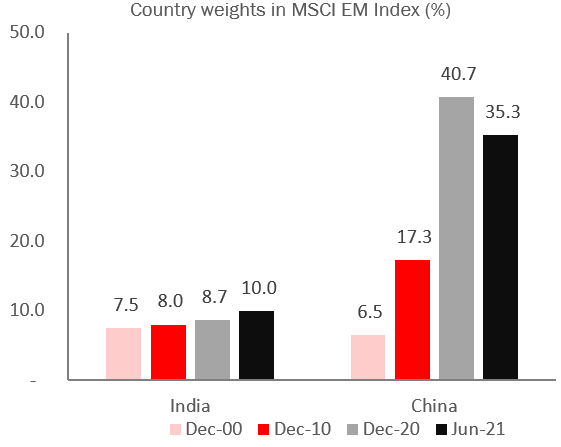
Figure 2: China markets evolution
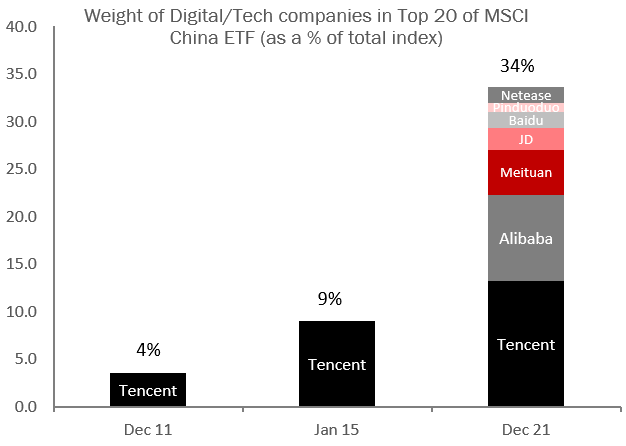
As you can see in Figure 1, In December 2000, India had a slightly larger weight than China in MSCI's Emerging Market Index (7.5% vs 6.5%). China's presence in that benchmark has grown sevenfold whilst India's has remained static. Figure 2 explains, in part why this has happened with 35% of the Chinese Index being constituted of technology-enabled companies in the Top 20 itself.
Thus, as more of the new-age businesses get listed in public markets in the next few years, India's free-float market capitalisation will rise and with it its representation in global indices. As India gets 'Too big to ignore', we will see global investors increasingly making a dedicated country allocation to India rather than as a part of an emerging market basket.
Participants in public markets will also need to consider how to evaluate 'high growth' tech-first companies whilst not losing sight of the transformation of legacy business models from the incumbent market players.
Evaluating 'new age' business models
To begin with, it is important to “de-glamourise” these businesses. More particularly relevant to India, most of these businesses are 'convenience' transaction platforms selling goods and services. It is just that they use digital technology to carry out their business.
Figures 3 and 4 provide an illustrative 'conceptual' framework to compare digital and conventional companies.
Figure 3: Conventional businesses
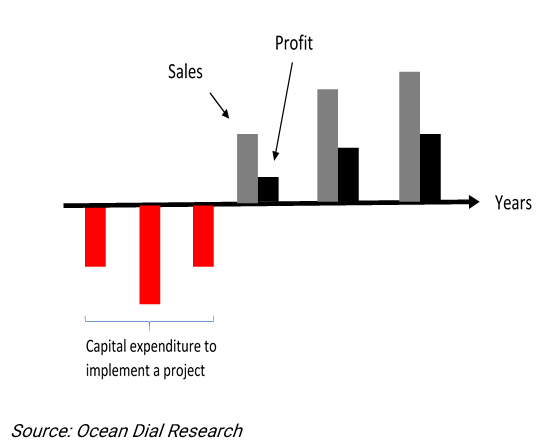
Figure 4: Digital/E-commerce businesses
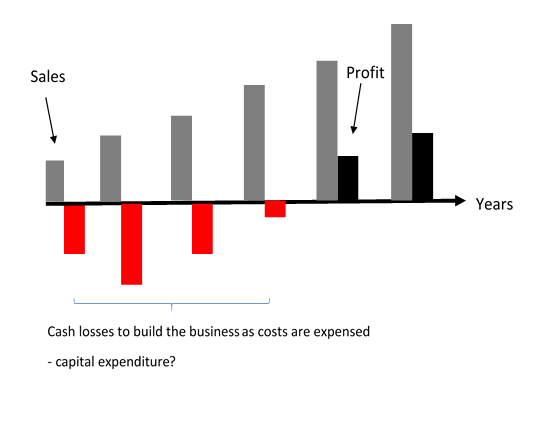
Conventional businesses tend to have a specific project implementation period followed by sales income and profits. Unlike this, digital companies are capital-light and usually earn sales income as they start the business. Initial years involve building scale in the industry by acquiring customers and changing consumer habits. Cash losses are thus inevitable and are essential for the buildout of the business. The same set of parameters needs to be used to analyze them as we do for conventional firms: the size of the opportunity, competitive landscape, operational excellence, corporate governance, unit economics, and path to profitability.
As always, it Is key to ask what problem is the business solving? In this context, there are two important aspects that we think public market participants need to account for:
• Is new demand being created by the new-age business in question? Is there an expansion of economic activity or is there just a redistribution of demand from an offline channel to an online channel? For example we believe new age, food delivery companies are creating new demand. Previously family dining was dominated by two options, cook and eat food at home or as a rarity, visit a restaurant. These food delivery companies are making it convenient to consume out-of-home food at home without the need for stepping into a restaurant. We think businesses that are creating 'new' demand can have substantial economic advantages and growth.
• Is the business 'accelerating' demand and/or fulfilling erstwhile 'unsatiated' demand? For instance, one Beauty and Personal care company, has successfully provided a wide variety of product assortments of up to 200,000 SKUs. This is simply not possible at scale with bricks and mortar retail. This alongside reach into India’s hinterland with over 60% of its business from Tier 2 and 3 towns, creates a powerful combination.
Quite obviously, it is important to examine whether the business is a dominant player or not. This is more crucial in this new age winner takes all space as the ability to 'burn' cash is dependent on the continued availability of funding.
How to Value them?
There is much debate about the inability to use relative valuation metrics such as P/E or EV/EBITDA in the absence of profits, to value these businesses. We think this debate is avoidable. The value of any business is always the present value of future cash flows expected from the business. Relative valuation measures such as P/E, EV/EBITDA, or Price to Sales are all mere approximations of the DCF and are in vogue for their ease of use. In any case, near-term relative valuations will always be misleading and optically high in these businesses as they have yet to reach a steady state. They are still in a high growth phase, and all benefits are back-ended.
To support this argument, we show in Figure 5 below, the Free Cash Flow (FCF) profile of two hypothetical companies: Boring old Business Ltd (BB) and Shiny New Tech Play Ltd. (SNTP). Both are assumed to have the same business valuation based on the present value of future cash flows. Based on this, BB gets a relative valuation of 30X P/E while SNTP has no such relative valuation measure to express based on the near term due to losses.
Figure 5: Hypothetical FCF profile of a conventional and new age business
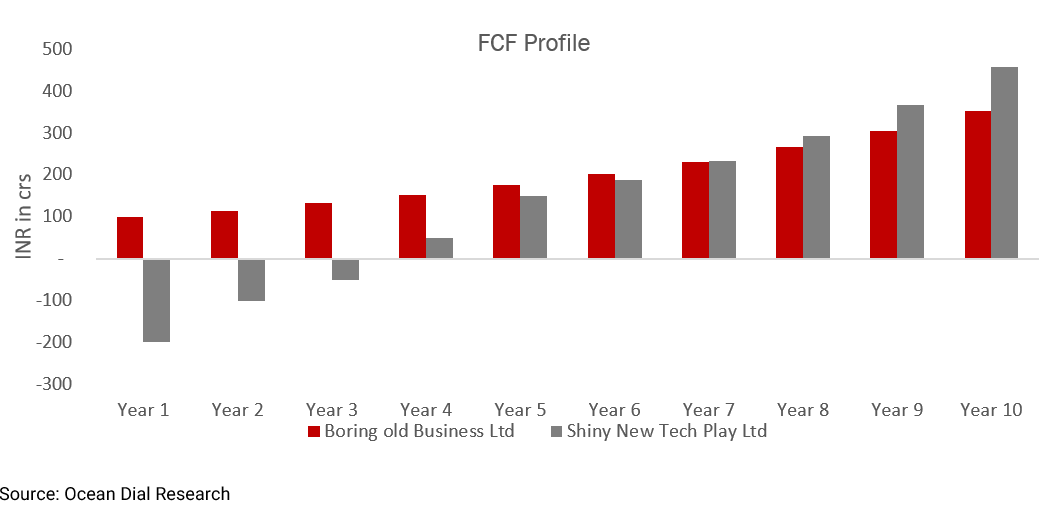
Due to the absence of profits in the immediate term, the risk of overvaluation is always there in such businesses. Thus, our preference is to use a Reverse DCF analysis. It allows us to gauge embedded expectations in the current share price regarding specific critical parameters in the future. For example, if the current share price were the 'true' value of Zomato, then what is the embedded expectation in terms of annual growth of its Monthly Transacting Users (MTU) over the next few years? If the embedded expectation of growth is lower compared with actual expectations, then the company is undervalued and vice versa.
Digital transformation of Conventional businesses
More than the listing of new-age businesses, we think there will be significant investment opportunities in conventional businesses due to their digital transformation. Digital adoption has moved from "nice to have" to "must-have". Conventional approaches are too linear and static whereas technology gives management teams a competitive advantage from feedback loops through data for improving supply chains, operating costs, and customer engagement. See Figure 6 below.
Figure 6: Digital feedback loops for conventional businesses

Digitalisation allows companies to create new value and experiences that provide differentiation and a competitive edge.
Conventional businesses are keen not to lose their hard-fought membership of the status quo to disruptors. The online channels of India’s big conglomerates are now complementing conventional channels to provide an 'omni-channel' experience for demand-fulfilment. Many incumbent brands have also introduced online first brands to get customer feedback before introducing them into the offline market. Online sales are already at single digit highs for many consumer companies. As the 2000 tech bubble taught us, we mustn't obsess with internet companies. Public equity market participants will increasingly have to consider the digital strategies of conventional businesses as well in their analysis.
Conclusion
Change in market structure, new business models, the transformation of conventional business models, and updated valuation frameworks are some of the factors which Indian public market investors will need to consider. Hype exists around both temporary blips and paradigm shifts. The danger of capital loss is greater when we ignore sound investment principles even when the hype around the macro story is justified. Our next note will dive into greater details into how our portfolio strategy is focusing on businesses benefiting from changes of this magnitude.
